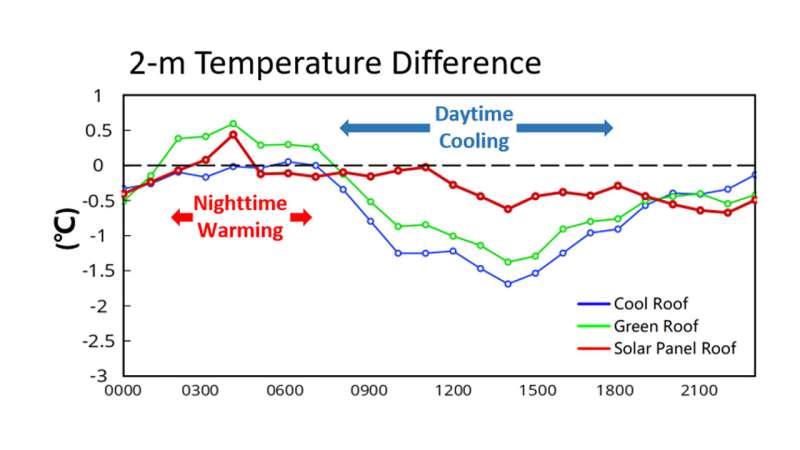Concrete sidewalks, black asphalt streets, traffic, brick and steel buildings. These common city elements can retain heat and increase temperatures in a phenomenon called the urban heat island effect.
With increasingly warming temperatures during the summer months, urban cities like Chicago need to arm decision makers and communities with information about strategies to help keep their residents cool. One strategy involves something all buildings already have: a roof. Certain roofing materials can help cool the surrounding outside air and decrease the need for air conditioning (AC).
To help understand how climate is affecting urban communities, researchers at the U.S. Department of Energy’s (DOE) Argonne National Laboratory examined three different types of roofing strategies and their impact on near-surface temperature and cooling energy demand through regional modeling in the Chicago metropolitan area.
“We chose to run our model during a heat wave event—where temperatures cross the 95th percentile observed in a city for three consecutive days—as opposed to average summer temperatures so that we could maximize potential benefits,” said Rao Kotamarthi, science director for Argonne’s Center for Climate Resilience and Decision Science (CCRDS) and author of the study.
The team ran a regional climate model simulating the Chicago metro area and three types of roofs: cool (painted a heat-reflecting white), green (vegetation) and solar panels.
They found that the three types of roofs reduced the near-surface temperature and AC consumption demand during daytime hours when air temperature is the highest. Cool roofs reduced the near-surface temperature by 1.5 degrees Celsius, followed by 1.2 degrees for green roofs and 0.6 degrees for solar panel roofs across the Chicago area.
Because all the roofing strategies offer cooling effects, they reduce AC consumption. Cool roofs reduced AC energy consumption the most, followed by green roofs and solar panel roofs. Energy demand was shown to be reduced by 16.6%, 14.0%, and 7.6%, when cool roofs, green roofs and solar panel roofs are deployed, respectively.
Overall, the large-scale deployment of cool roofs showed the best potential for cooling effects and cooling energy saving. They cost less than the other two technologies, and they do not require additional water. However, they are not helpful in managing stormwater loads as green roofs have the potential to do. Stakeholders can use results of the study to inform sustainable development approaches, lower summertime cooling energy demand, and help minimize greenhouse gas emissions in the long term over the Chicago region.
This work was conducted as part of the Community Research on Climate & Urban Science (CROCUS) Urban Integrated Field Laboratory. CROCUS is led by Argonne in partnership with academic and community organizations and civic and industry champions. Focused on the Chicago region, CROCUS studies urban climate change and its implications for environmental justice.

The results of this baseline study will help CROCUS communities plan and test mitigation options. The researchers will work closely with CROCUS community organizations and members.
“The difference in cost between the roofs is approximately a factor of three,” said Kotamarthi, who is also the CROCUS science director. “Which option is the most cost effective to get the most benefit? If a community is deciding on a strategy, we can look at the model and give them an actual answer.”
And the results are a good starting point for what the researchers hope to achieve next, a city-scale and global-scale model for each of the roofing options. But how do you incorporate a green roof into a computer model? First, researchers will work to better understand green roofs by taking measurements at surface and building levels to improve on how a green roof is represented.
“We have very few measurements for green roofs,” said Kotamarthi. “We need to measure how much energy goes in, how much goes out, and how much water it needs and how fast it retains it. We need these measurements to give us a complete understanding of the process so we can refine calculations and models.”
Researchers will measure the roofs of CROCUS partners throughout the city. For instance, Northeastern Illinois University has both roof types, while other partner buildings have solar panels.
Finally, the researchers want to improve the resolution of the model all the way down to street scale. Kotamarthi explained that achieving this will help them see the difference between houses and streets, which is important because it will help answer questions such as, if a tree is planted, how much does it cool the nearby building and the pavement?
The team’s research used supercomputing resources at the Argonne Leadership Computing Facility (ALCF) and the National Energy Research Scientific Computing Center (NERSC). The ALCF and NERSC are DOE Office of Science user facilities located at Argonne and Lawrence Berkeley National Laboratory, respectively.
More information:
Haochen Tan et al, Impact of different roofing mitigation strategies on near-surface temperature and energy consumption over the Chicago metropolitan area during a heatwave event, Science of The Total Environment (2022). DOI: 10.1016/j.scitotenv.2022.160508
Citation:
Can a roof’s material cool the outside air and lower energy demand? (2023, September 30)
retrieved 30 September 2023
from https://techxplore.com/news/2023-09-roof-material-cool-air-energy.html
This document is subject to copyright. Apart from any fair dealing for the purpose of private study or research, no
part may be reproduced without the written permission. The content is provided for information purposes only.

